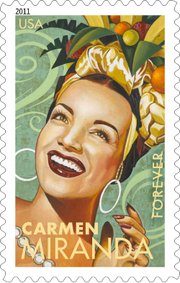It has been more than 70 years since Brazilian singer and actress Carmen Miranda rose to fame as the "Lady in the Tutti Frutti Hat," becoming one of the highest-paid actresses of the 1940s and encouraging Americans to try bananas in the process.
Now, another Hispanic actress, Sofia Vergara, has held fast to the mantle of highest-paid actress on television. But how much have things changed since Miranda was dispatched to improve American sentiment toward Latin America?
"It's complicated," said Angharad Valdivia, a research professor at the University of Illinois-Urbana Champaign. Valdivia focuses on the intersections of gender, ethnic and Latin American studies with pop culture.
Vergara's movie Hot Pursuit, which she co-produced and co-stars in with Reese Witherspoon, opened May 8 in an environment where Latin American relations have once again taken center stage as President Barack Obama has normalized ties with Cuba and declared the days of the United States "meddling" in Latin America over.
Vergara has attained rarefied levels of success, and she's done it while operating within a narrow framework of how Hispanics are viewed in America. In the years since Miranda first hit pay dirt, some stereotypes persist, especially when it comes to the way Hispanic bodies should look and how women present themselves. In Vergara's case, that meant dyeing her famously cascading locks from blond -- her natural hair color -- to brunette.
"The fact is, she does not manage a successful crossover until she fulfills this stereotype of the voluptuous Latina and the voluptuous Latina is almost always brown-haired," Valdivia said. "In fact, that's what makes her Latina in relation to white men. When you go back to Carmen Miranda, Carmen Miranda was playing in relation to say, Betty Grable. So Carmen Miranda was the brown-haired one in relation to the blond women in cinema."
In Vergara's case, her brown hair serves to set her apart from Julie Bowen's very blond Claire Dunphy on Modern Family.
Miranda's road to the mainstream was paved with similar compromises.
When Miranda arrived in Hollywood, the darker-skinned members of her group Bando da Lua were gradually phased out to promote an image of Brazilians who looked Mexican at the behest of studio executives, according to Helena Solberg, director of a film of Miranda's life called Bananas Is My Business. Miranda became one of the highest-paid women in Hollywood playing a Latin American composite, a white Portuguese woman singing the music of poor black Brazilians.
Even though Miranda was Portuguese, she assimilated all of Brazil and had a Brazilianness that few Brazilians have," Maria Carmen Barbosa, the playwright who co-wrote South American Way: The Carmen Miranda Musical, told The New York Times in 2001. "She was irreverent, had street smarts, wit, daring and an impressive innate musicality."
For Vergara, acting was always a means to an end. Before her star began to rise with the circulation of a 1989 Colombian Pepsi commercial, Vergara was studying to become a dentist.
When she decided to lean in to her show business career in earnest, she became a talk show host in Colombia. In 1994, after she moved to Miami and became a well-known entity on Univision, she co-founded an agency, Latin World Entertainment, to represent Spanish-speaking talent Univision had been muscling into bad deals, according to Vanity Fair. The network, the only Spanish-language game in town, would lean on talent to sign contracts in English that they barely understood, without the opportunity to have documents reviewed by a lawyer. Univision did not respond to requests from The Washington Post for comment.
Vergara has effectively leveraged her stardom to become the highest-paid woman on TV for several years running. In doing so, she has become an unironic distillery and distributor of Hispanic essentialism, not unlike Miranda.
She employs her Latin-ness, or rather, a version of her Latin-ness filtered through an American lens, to sell everything from a line of clothes at Kmart (since dissolved) to perfume and jewelry. In the English-language Kmart ads, Americans saw a Colombian woman marketing her clothing as universal, while maintaining that they should be made for women with more bosom and bottom. She's providing color, movement and interest in contrast to the bland white professionals charged with making her line a reality.
It works. Vergara gets a reported $325,000 per episode for Modern Family, and pulls in even more cash thanks to a long list of English- and Spanish-language endorsement deals.
Miranda was courted to sell a very different product. She was instrumental in promoting the United States' Good Neighbor Policy, which dictated that the United States stop interfering in Latin American affairs and eventually led to the U.S. Marines abandoning their occupation of Nicaragua and Haiti. Miranda wasn't just a cultural force, but a geopolitical one. Her movie The Gang's All Here was practically propaganda for the Good Neighbor Policy.
"It's about trade," Valdivia said. "It's about politics. It's about tourism. It's about the United Fruit Co. It's about packaging that. As [Bananas, Beaches and Bases author] Cynthia Enloe has said, it's about packaging bananas to make bananas a major consumable fruit. People didn't used to consume bananas in the United States and they didn't know what to do with them. They had to be taught to consume bananas. Part of what Carmen Miranda did was diplomacy. It was pedagogical, teaching the U.S. public to consume this fruit that was so weird and so tropical."
In 2012, the cast of Modern Family, including Vergara, met the president in the Oval Office on a White House tour. Seventy years after Miranda's work with Franklin Roosevelt's administration, Vergara pooh-poohed the idea of having a serious conversation with Obama.
"I don't think he wanted me to talk profound things," Vergara said on Howard Stern's radio show. "Oh, let's sit down right now to talk about the situation with trade in Colombia, Mr. President. ... You have to respect his time. He has more important things to do than talk with me, chatting."
Vergara has played up the very element that makes people see her differently, and in doing so, has become rich. But she also runs the risk of becoming a parody of herself, Valdivia said, much like Charo.
Vergara understands how to exploit her public-facing image to great effect, something she has demonstrated as she navigates the most serious public controversy of her career: the legal battle she's facing with ex-fiance Nick Loeb over their frozen embryos. Loeb wants to implant them in a surrogate and raise the children himself. Vergara cites a contract they both signed stipulating that they must both consent in order for that to happen, and she does not wish to consent.
She spoke about the lawsuit recently on Good Morning America and The Howard Stern Show. "More than a mother, [a child] needs a loving relationship of parents that get along, that don't hate each other," she told Stern. "I don't hate him, but obviously he has a problem with me."
It was a rare departure from her lighthearted, giggly, flirty persona. Vergara has, when possible, taken the constraints of her bombshell image and bent them to her will. She uses her accent, which she plays up to cartoonish affect, as a disarming mechanism. "It's good because people ... lower their guards," and mistakenly assume she's not smart, she told Stern.
"There's no way to mine this as successfully as she has if you're not incredibly smart," Valdivia said. "There are flash-in-the-pan bombshells that come and go all the time."
GETTING HER DUE
In Brazil, Miranda is finally getting her due. Before, the Carmen Miranda museum, which opened in 1976, was housed in a squat, unassuming building in Rio de Janeiro. But now Brazil's Museum of Image and Sound in Copacabana is dedicating a permanent exhibition to Miranda and her music. Miranda was one of the biggest music acts in Brazil for 10 years before she left for Hollywood.
Vergara's Modern Family character, Gloria Delgado-Pritchett, possesses an understated cunning that almost borders on the subversive, although she's often presented as a stereotype. Gloria almost always gets what she wants, outwitting husband Jay, and stepdaughter Claire, with whom she is often at odds. What's more, the Pritchetts seldom realize Gloria is manipulating them.
"Is that subversion that's written into the role something that's communicating itself to the audience?" Valdivia said. "Is the majority of the audience just seeing 'there she is, she can't speak English, she's a trophy wife, she's just a Latin bombshell'?''
When confronted with concerns that she's playing a stereotype, Vergara asked Vanity Fair, "Who wouldn't want to be Gloria?" If Miranda is any indicator, it may take some time before the value of Gloria Delgado-Pritchett and the actress who plays her is truly realized.
"The dialogue she gets in Modern Family is very witty," Valdivia said. "I'm just not sure people are getting beyond the bombshell."
Style on 05/17/2015

